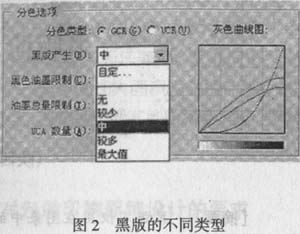
If the neutral grey is represented by a pure black version, it is a black version of the Maxium type; neutral grey is represented by yellow, magenta, and blue, then the black version is 0%, the black version is None, and the yellow, quality When the red, green, and black colors represent neutral gray, the black version of the Internet version changes in size, such as Light, Medium, and Heavy. Such as color R163G163B163, can be divided according to the following situations:
When the black version is Light, the color separation result is Y40% M33% Y33% K1%; when the black edition is Medium, the color separation result is C37% M30% Y30% K7%; when the black edition is Heavy, the color separation result is C26% M20% Y20% K22%.
Although there are large differences between the separation results, the printing results should be similar. The above is the result of separation of neutral gray. In fact, the black version will have different effects on the complex color in the image. Because the complex color contains a gray component, the gray component also exists in the distribution of yellow and magenta. Problems with the ratio of the blue and green editions.
4 Matching of black print and background removal
With the darkening of the dark tone, the background color removal process is required to reduce the overall darkness of the image. Under color removal is performed only on the three primary color plates, and is performed only in the neutral gray region. Pure and saturated regions have no or little background color removal. The amount of background removal can be set individually, but the starting point must be the same. The key is to ensure that after the ground color is removed, the printing balance of the three-primary version of the level curve is printed.
As shown in FIG. 3, the starting point of the under color removal can be selected at the full tone level point, and the same removal amount can be effected within different tone ranges. In order to make the three primary color level reproduction curve smooth, there is no obvious turning point, does not flatten the image level, except for special needs, generally should increase the removal range with the increase in the amount of background removal. Especially for a large number of background color removal, the full-tone range should be removed.

5 Conclusion
Color printing needs to use the black version to cover up the lack of printing and color cast, improve the density of the medium and dark tone levels, and stabilize the reproduction of gray balance.
a. The choice of the tone of the black edition has both regularity and flexibility, which restricts the reproduction of the image tone level (especially the dark tone) to a greater extent;
b. In order to change the length and depth of the blacktone tone, it is necessary to use the short tone black plate as a benchmark to remove the background color from the three primary color dot layer copying curves.
c. The effective use of the black version not only adds black to the three primary colors, but also reduces the amount of ink in the three primary colors in the black part, so that the black version can be used to open the dark fade level and enhance the image contrast.
d. The use of black-tone tone-level transformation and background color removal is also a component of image-level adjustment and gray-balance replication, and is mainly used in shadow adjustment.
At present, most electric points and desktop system operators do not pay much attention to the black version. They do not realize the importance of the black version. As a result, many of the products are too dark and dark, resulting in dark shadows. The second is that the black version is too shallow. There are no contrasts in the image and there is no intensity. In fact, with a good black version, you can enhance image contrast, enhance the dark tone level, make the dark part strong, and have a strong sense of body, which is one of the keys to enhancing the image aesthetics and improving the image quality.
[ references]
[1] Xu Jinlin, et al. Offset image processing principle [M]. Xi'an: Shaanxi Science and Technology Press, 1998.
[2] Feng Zi. Electronic Color Separation Platemaking Project [M]. Beijing: Printing Industry Press, 1997.
[3] Liu Wuhui. Computer graphic design and prepress graphic processing 500 [M]. Beijing: Beijing Hope Electronic Publishing House, 2002.
(Finish)